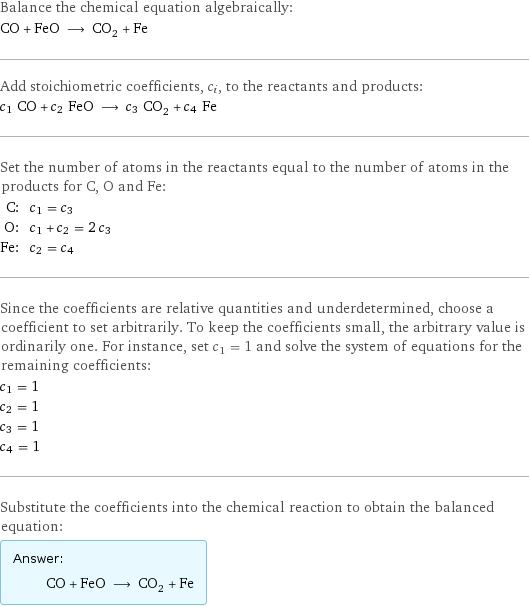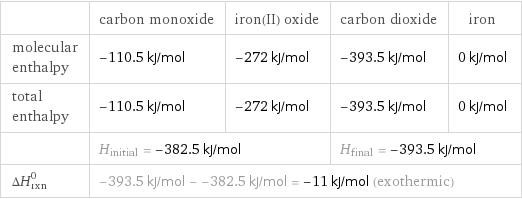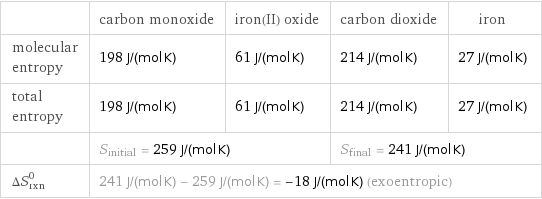Input interpretation

CO (carbon monoxide) + FeO (iron(II) oxide) ⟶ CO_2 (carbon dioxide) + Fe (iron)
Balanced equation

Balance the chemical equation algebraically: CO + FeO ⟶ CO_2 + Fe Add stoichiometric coefficients, c_i, to the reactants and products: c_1 CO + c_2 FeO ⟶ c_3 CO_2 + c_4 Fe Set the number of atoms in the reactants equal to the number of atoms in the products for C, O and Fe: C: | c_1 = c_3 O: | c_1 + c_2 = 2 c_3 Fe: | c_2 = c_4 Since the coefficients are relative quantities and underdetermined, choose a coefficient to set arbitrarily. To keep the coefficients small, the arbitrary value is ordinarily one. For instance, set c_1 = 1 and solve the system of equations for the remaining coefficients: c_1 = 1 c_2 = 1 c_3 = 1 c_4 = 1 Substitute the coefficients into the chemical reaction to obtain the balanced equation: Answer: | | CO + FeO ⟶ CO_2 + Fe
Structures

+ ⟶ +
Names

carbon monoxide + iron(II) oxide ⟶ carbon dioxide + iron
Reaction thermodynamics
Enthalpy

| carbon monoxide | iron(II) oxide | carbon dioxide | iron molecular enthalpy | -110.5 kJ/mol | -272 kJ/mol | -393.5 kJ/mol | 0 kJ/mol total enthalpy | -110.5 kJ/mol | -272 kJ/mol | -393.5 kJ/mol | 0 kJ/mol | H_initial = -382.5 kJ/mol | | H_final = -393.5 kJ/mol | ΔH_rxn^0 | -393.5 kJ/mol - -382.5 kJ/mol = -11 kJ/mol (exothermic) | | |
Entropy

| carbon monoxide | iron(II) oxide | carbon dioxide | iron molecular entropy | 198 J/(mol K) | 61 J/(mol K) | 214 J/(mol K) | 27 J/(mol K) total entropy | 198 J/(mol K) | 61 J/(mol K) | 214 J/(mol K) | 27 J/(mol K) | S_initial = 259 J/(mol K) | | S_final = 241 J/(mol K) | ΔS_rxn^0 | 241 J/(mol K) - 259 J/(mol K) = -18 J/(mol K) (exoentropic) | | |
Equilibrium constant
![Construct the equilibrium constant, K, expression for: CO + FeO ⟶ CO_2 + Fe Plan: • Balance the chemical equation. • Determine the stoichiometric numbers. • Assemble the activity expression for each chemical species. • Use the activity expressions to build the equilibrium constant expression. Write the balanced chemical equation: CO + FeO ⟶ CO_2 + Fe Assign stoichiometric numbers, ν_i, using the stoichiometric coefficients, c_i, from the balanced chemical equation in the following manner: ν_i = -c_i for reactants and ν_i = c_i for products: chemical species | c_i | ν_i CO | 1 | -1 FeO | 1 | -1 CO_2 | 1 | 1 Fe | 1 | 1 Assemble the activity expressions accounting for the state of matter and ν_i: chemical species | c_i | ν_i | activity expression CO | 1 | -1 | ([CO])^(-1) FeO | 1 | -1 | ([FeO])^(-1) CO_2 | 1 | 1 | [CO2] Fe | 1 | 1 | [Fe] The equilibrium constant symbol in the concentration basis is: K_c Mulitply the activity expressions to arrive at the K_c expression: Answer: | | K_c = ([CO])^(-1) ([FeO])^(-1) [CO2] [Fe] = ([CO2] [Fe])/([CO] [FeO])](../image_source/d5ea587b6bdc261febd0f10a6952a232.png)
Construct the equilibrium constant, K, expression for: CO + FeO ⟶ CO_2 + Fe Plan: • Balance the chemical equation. • Determine the stoichiometric numbers. • Assemble the activity expression for each chemical species. • Use the activity expressions to build the equilibrium constant expression. Write the balanced chemical equation: CO + FeO ⟶ CO_2 + Fe Assign stoichiometric numbers, ν_i, using the stoichiometric coefficients, c_i, from the balanced chemical equation in the following manner: ν_i = -c_i for reactants and ν_i = c_i for products: chemical species | c_i | ν_i CO | 1 | -1 FeO | 1 | -1 CO_2 | 1 | 1 Fe | 1 | 1 Assemble the activity expressions accounting for the state of matter and ν_i: chemical species | c_i | ν_i | activity expression CO | 1 | -1 | ([CO])^(-1) FeO | 1 | -1 | ([FeO])^(-1) CO_2 | 1 | 1 | [CO2] Fe | 1 | 1 | [Fe] The equilibrium constant symbol in the concentration basis is: K_c Mulitply the activity expressions to arrive at the K_c expression: Answer: | | K_c = ([CO])^(-1) ([FeO])^(-1) [CO2] [Fe] = ([CO2] [Fe])/([CO] [FeO])
Rate of reaction
![Construct the rate of reaction expression for: CO + FeO ⟶ CO_2 + Fe Plan: • Balance the chemical equation. • Determine the stoichiometric numbers. • Assemble the rate term for each chemical species. • Write the rate of reaction expression. Write the balanced chemical equation: CO + FeO ⟶ CO_2 + Fe Assign stoichiometric numbers, ν_i, using the stoichiometric coefficients, c_i, from the balanced chemical equation in the following manner: ν_i = -c_i for reactants and ν_i = c_i for products: chemical species | c_i | ν_i CO | 1 | -1 FeO | 1 | -1 CO_2 | 1 | 1 Fe | 1 | 1 The rate term for each chemical species, B_i, is 1/ν_i(Δ[B_i])/(Δt) where [B_i] is the amount concentration and t is time: chemical species | c_i | ν_i | rate term CO | 1 | -1 | -(Δ[CO])/(Δt) FeO | 1 | -1 | -(Δ[FeO])/(Δt) CO_2 | 1 | 1 | (Δ[CO2])/(Δt) Fe | 1 | 1 | (Δ[Fe])/(Δt) (for infinitesimal rate of change, replace Δ with d) Set the rate terms equal to each other to arrive at the rate expression: Answer: | | rate = -(Δ[CO])/(Δt) = -(Δ[FeO])/(Δt) = (Δ[CO2])/(Δt) = (Δ[Fe])/(Δt) (assuming constant volume and no accumulation of intermediates or side products)](../image_source/be406a3d721d36f7b4b31b02f37ac146.png)
Construct the rate of reaction expression for: CO + FeO ⟶ CO_2 + Fe Plan: • Balance the chemical equation. • Determine the stoichiometric numbers. • Assemble the rate term for each chemical species. • Write the rate of reaction expression. Write the balanced chemical equation: CO + FeO ⟶ CO_2 + Fe Assign stoichiometric numbers, ν_i, using the stoichiometric coefficients, c_i, from the balanced chemical equation in the following manner: ν_i = -c_i for reactants and ν_i = c_i for products: chemical species | c_i | ν_i CO | 1 | -1 FeO | 1 | -1 CO_2 | 1 | 1 Fe | 1 | 1 The rate term for each chemical species, B_i, is 1/ν_i(Δ[B_i])/(Δt) where [B_i] is the amount concentration and t is time: chemical species | c_i | ν_i | rate term CO | 1 | -1 | -(Δ[CO])/(Δt) FeO | 1 | -1 | -(Δ[FeO])/(Δt) CO_2 | 1 | 1 | (Δ[CO2])/(Δt) Fe | 1 | 1 | (Δ[Fe])/(Δt) (for infinitesimal rate of change, replace Δ with d) Set the rate terms equal to each other to arrive at the rate expression: Answer: | | rate = -(Δ[CO])/(Δt) = -(Δ[FeO])/(Δt) = (Δ[CO2])/(Δt) = (Δ[Fe])/(Δt) (assuming constant volume and no accumulation of intermediates or side products)
Chemical names and formulas

| carbon monoxide | iron(II) oxide | carbon dioxide | iron formula | CO | FeO | CO_2 | Fe name | carbon monoxide | iron(II) oxide | carbon dioxide | iron IUPAC name | carbon monoxide | oxoiron | carbon dioxide | iron